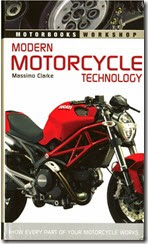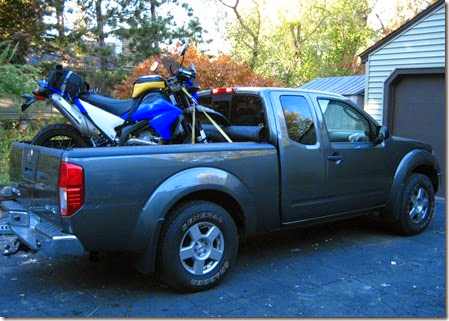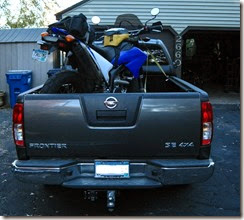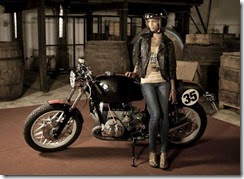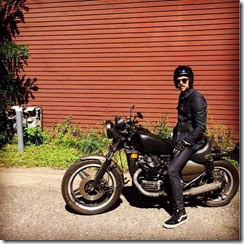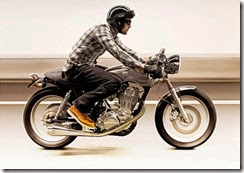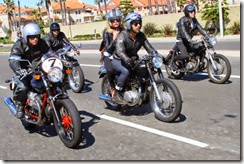All Rights Reserved © 2008 Thomas W. Day
A friend, who wrote a book about motorcycle crashes and what the rest of us can learn from the mistakes of those who will admit to falling down, once asked a few riders to send him an accounting of their favorite trip to the hospital. Since I quit racing dirt bikes, I've been mostly without anything interesting to report. That doesn't mean that I've been especially cautious, competent, or any other c-word that implies something positive about my riding habits. It mostly means that I've been lucky. In my twenty-year street riding career, I've ridden while suffering hypo and hyperthermia, I've pushed on for hundreds of miles when I should have found a place to park and warm up or cool down, and I’ve risked life and limb with impaired riding skills due to temperature.
Mostly, it has been cold weather that caused me the most risk. I do not ride well when I’m cold. One of the keys to riding smoothly is to be relaxed at the bars. That becomes especially critical when your tires are cold, the road is unpredictably slick from rain or spots of frozen water, and when visibility is reduced. You can only shake out the tension so many times, to get some level of flexibility back into your arms and legs when you are freezing. Sooner, rather than later, you need to get warm or you risk crashing and getting hurt. Getting hurt when you are cold feels even worse than when you aren’t freezing your nuts off.
I used to play dirt biker year-round. When I lived in Texas and Nebraska, I raced all season and played racer all winter. A few years before that, in Kansas, I raced in the summer and commuted on the same bike (a 250cc Harley Sprint) six days a week to work and school. I moved from Nebraska to California by Honda CX500 in late March, 1983. My family followed, by train, a few months later. Sometimes it seems that I’ve ridden more miles cold than comfortable. The older I get, the less inclined I am to put in long, cold miles. I suck at it, so I’m learning not to do it.
Not long after I moved to California, a friend from Colorado wanted to do a tour of the Golden State. We planned to meet at an undetermined campground in Yosemite and start our adventure from there. As usual, I didn’t escape from work until dark. As usual, I hadn’t planned the trip any further than picking a spot and a general time when I was supposed to be at that destination. I rolled the CX into heavy traffic on I405 and headed north until I had to choose between going the fast route, I5, in boring commuter traffic and the scenic route, California’s famous Pacific Coast Highway along one of the most spectacular coastlines in the world. Even with my messed up “schedule,” I picked PCH and left the traffic. North of Santa Barbara you leave the L.A. atmosphere and California turns into “California.” The air is breathable, the natives are less restless, the scenery is incredible, and gas is expensive.
Without a thought in my head, beyond driving toward point B, I followed the highway with the setting sun supplying a reader’s light, falling just over my left shoulder. Until it got dark, just a few miles before I made it to San Luis Obispo, my trip was progressing better than I could have imagined. My usual travel habit is to create my schedule as I go. Somewhere along the road I’d decided that I needed to make it to Carmel that first day of travel. If you know the area, you’ll be noticing by now that my course wasn’t the short route from point A to B. In fact, I practically doubled the necessary miles by putting PCH and Carmel in the travel plan. “Logic be damned, full speed ahead” could be the title for a vacation planning book I might someday write.
Pushing on in the dark and rapidly dropping temperature, I made it to the edge of Big Sur and I was getting cold. The air was wet and cold and a strong wind was blowing from the ocean. I knew it was stupid to be riding through this incredible place in the dark, for scenic reasons, but I had set Carmel in my sights and I was going to make Carmel or die trying.
The Pacific coast had taken a severe weather beating that spring. Much of PCH had washed down the cliffs and I’d been redirected on several non-scenic detours around swept away sections earlier in the day. Big Sur doesn’t offer many options to the state's highway engineers, so quick patches are more practical than detours. Half-frozen, tired, and stupid, I whipped around a mountain curve to discover one of those quick repairs; an off-camber, gravel and broken asphalt section of road, bordered by a large pile of rocks on both sides. No way was I going to make this corner. I came into it way too hot, in poor position, and with limited skills. I was too cold to control the tension in my arms, so instead of pushing the bike as far into the corner as I could, I wasted my remaining strength pitting my left arm against my right arm. I headed for the pile of rocks furthest from the ocean, only partially intentionally.
The CX500 was my first street bike, since I’d stripped down a 1963 Harley Sprint to make it into a ¼ mile scrambler. I sucked on asphalt, but I had twenty years of off-road riding under my belt. Highways I didn’t know, rocks I did. When you are in a panic situation, conscious decisions get put away for better moments. Panic reactions are either controlled by practice or fight-or-flight. Without thinking about the kind of bike I was riding, I straightened up the bike, scrubbed off as much speed as I could before the front wheel hit the first rock, stood up on the pegs, got my weight as far back as my soft saddle bags and stubby legs would allow, and got back on the little twin's gas. A fraction of a second later, I was stopped at the end of the line of rocks, wondering what had happened and how I managed to be in that spot undamaged.
When I started back up, the bike was incredibly noisy and it handled weirdly. I rode for a mile or two until I spotted a grassy outcropping overlooking the ocean, pitched my tent, and crawled into my sleeping bag to shiver uncontrollably until I drifted into sleep. Five hours later, I struggled out of the tent and examined my bike. The exhaust headers were flattened and the mufflers were ripped from their clamps and pulled back about 2” from the end of the headers. My centerstand was busted to bits and the stand’s mount was smashed and ripped from the frame. The oil filter was dented, but not leaking. The bottom of the engine was scarred, but not busted. The front wheel was no longer round, the Comstar’s rim was intact, but one of the rivets that attached the hub to the wheel support was missing. The tire held air. The rear tire was gouged up, badly, but it appeared to be functional (that assessment would cause serious problems for me a thousand miles later). A couple of lower frame bolts were sheared off. Pretty much, the bottom side of the bike looked like it had been drug across a pile of rocks.
I removed the centerstand, cobbled the exhaust together with wire and snot, installed a new filter and oil (dirtbikers carry spares), and wobbled into Carmel, wounded and reprimanded. Carmel is too small to have a bike shop and too snooty to give a crap, so I kept riding until I got to Monterey. I found a Honda shop, bought some parts (including a new front wheel and centerstand from a recently rear-ended CX customer), and did my repair work in the shop’s driveway. The Honda mechanic even loaned me some tools and helped me straighten my exhaust headers enough to make a fair muffler seal with the new clamps. A welding shop cut off the old centerstand bits and installed a makeshift replacement. Six hours later, I was on my way to Yosemite.
I survived my first half-frozen street incident. I managed to learn next-to-nothing from the experience and put myself in similar situations several times in the next twenty years, but I’m beginning to realize that I am never going to be a good cold weather rider and I compensate, a little, for that disability. Now, when I can’t relax my arms, I take that as a sign that I’m too cold to ride and start looking for a motel or campground. It’s been too many years since I actually rode on rocks on purpose and I’m sure my panic reactions are less conditioned than they were on that trip. I don’t want to test myself, so we’ll just have to assume that is true.
March 2009
